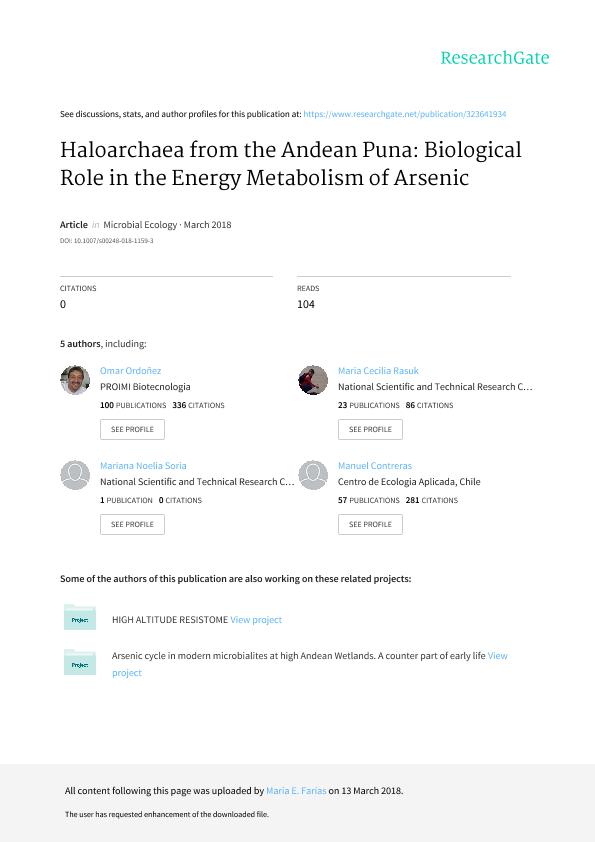Mostrar el registro sencillo del ítem
dc.contributor.author
Ordoñez, Omar Federico

dc.contributor.author
Rasuk, Maria Cecilia

dc.contributor.author
Soria, Mariana Noelia

dc.contributor.author
Contreras, Manuel
dc.contributor.author
Farias, Maria Eugenia

dc.date.available
2018-11-14T15:25:29Z
dc.date.issued
2018-10
dc.identifier.citation
Ordoñez, Omar Federico; Rasuk, Maria Cecilia; Soria, Mariana Noelia; Contreras, Manuel; Farias, Maria Eugenia; Haloarchaea from the Andean Puna: Biological Role in the Energy Metabolism of Arsenic; Springer; Microbial Ecology; 76; 3; 10-2018; 695-705
dc.identifier.issn
0095-3628
dc.identifier.uri
http://hdl.handle.net/11336/64473
dc.description.abstract
Biofilms, microbial mats, and microbialites dwell under highly limiting conditions (high salinity, extreme aridity, pH, and elevated arsenic concentration) in the Andean Puna. Only recent pioneering studies have described the microbial diversity of different Altiplano lakes and revealed their unexpectedly diverse microbial communities. Arsenic metabolism is proposed to be an ancient mechanism to obtain energy by microorganisms. Members of Bacteria and Archaea are able to exploit arsenic as a bioenergetic substrate in either anaerobic arsenate respiration or chemolithotrophic growth on arsenite. Only six aioAB sequences coding for arsenite oxidase and three arrA sequences coding for arsenate reductase from haloarchaea were previously deposited in the NCBI database. However, no experimental data on their expression and function has been reported. Recently, our working group revealed the prevalence of haloarchaea in a red biofilm from Diamante Lake and microbial mat from Tebenquiche Lake using a metagenomics approach. Also, a surprisingly high abundance of genes used for anaerobic arsenate respiration (arr) and arsenite oxidation (aio) was detected in the Diamante’s metagenome. In order to study in depth the role of arsenic in these haloarchaeal communities, in this work, we obtained 18 haloarchaea belonging to the Halorubrum genus, tolerant to arsenic. Furthermore, the identification and expression analysis of genes involved in obtaining energy from arsenic compounds (aio and arr) showed that aio and arr partial genes were detected in 11 isolates, and their expression was verified in two selected strains. Better growth of two isolates was obtained in presence of arsenic compared to control. Moreover, one of the isolates was able to oxidize As[III]. The confirmation of the oxidation of arsenic and the transcriptional expression of these genes by RT-PCR strongly support the hypothesis that the arsenic can be used in bioenergetics processes by the microorganisms flourishing in these environments.
dc.format
application/pdf
dc.language.iso
eng
dc.publisher
Springer

dc.rights
info:eu-repo/semantics/openAccess
dc.rights.uri
https://creativecommons.org/licenses/by-nc-sa/2.5/ar/
dc.subject
Andean Puna
dc.subject
Arsenic
dc.subject
Bioenergetic Purposes
dc.subject
Chemolitotrophic Growth
dc.subject
Haloarchaea
dc.subject.classification
Otras Ciencias Biológicas

dc.subject.classification
Ciencias Biológicas

dc.subject.classification
CIENCIAS NATURALES Y EXACTAS

dc.title
Haloarchaea from the Andean Puna: Biological Role in the Energy Metabolism of Arsenic
dc.type
info:eu-repo/semantics/article
dc.type
info:ar-repo/semantics/artículo
dc.type
info:eu-repo/semantics/publishedVersion
dc.date.updated
2018-10-24T13:15:47Z
dc.journal.volume
76
dc.journal.number
3
dc.journal.pagination
695-705
dc.journal.pais
Alemania

dc.journal.ciudad
Berlin
dc.description.fil
Fil: Ordoñez, Omar Federico. Consejo Nacional de Investigaciones Científicas y Técnicas. Centro Científico Tecnológico Conicet - Tucumán. Planta Piloto de Procesos Industriales Microbiológicos; Argentina
dc.description.fil
Fil: Rasuk, Maria Cecilia. Consejo Nacional de Investigaciones Científicas y Técnicas. Centro Científico Tecnológico Conicet - Tucumán. Planta Piloto de Procesos Industriales Microbiológicos; Argentina
dc.description.fil
Fil: Soria, Mariana Noelia. Consejo Nacional de Investigaciones Científicas y Técnicas. Centro Científico Tecnológico Conicet - Tucumán. Planta Piloto de Procesos Industriales Microbiológicos; Argentina
dc.description.fil
Fil: Contreras, Manuel. Centro de Ecología Aplicada; Chile
dc.description.fil
Fil: Farias, Maria Eugenia. Consejo Nacional de Investigaciones Científicas y Técnicas. Centro Científico Tecnológico Conicet - Tucumán. Planta Piloto de Procesos Industriales Microbiológicos; Argentina
dc.journal.title
Microbial Ecology

dc.relation.alternativeid
info:eu-repo/semantics/altIdentifier/url/https://link.springer.com/article/10.1007/s00248-018-1159-3
dc.relation.alternativeid
info:eu-repo/semantics/altIdentifier/doi/https://dx.doi.org/10.1007/s00248-018-1159-3
Archivos asociados
